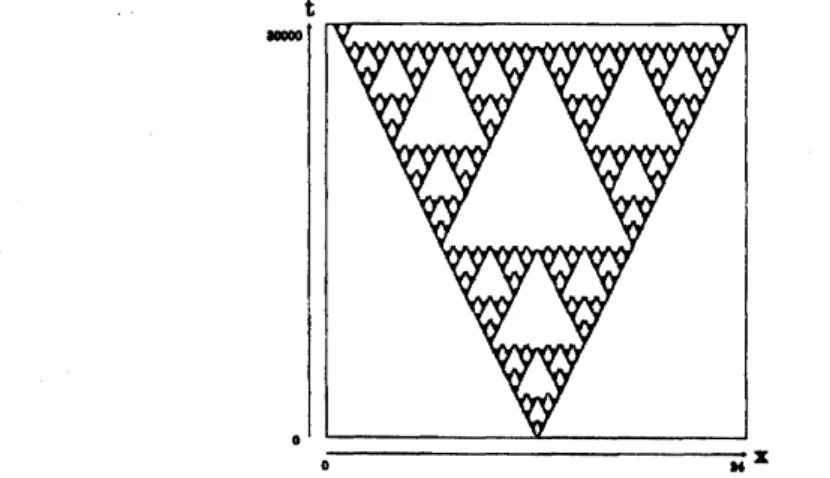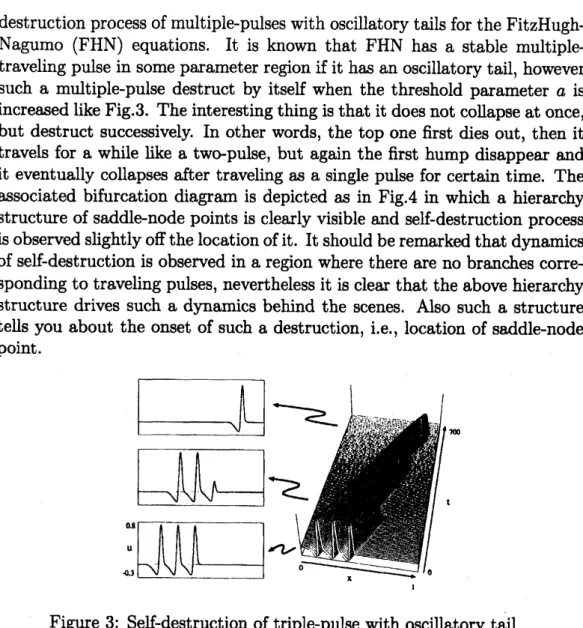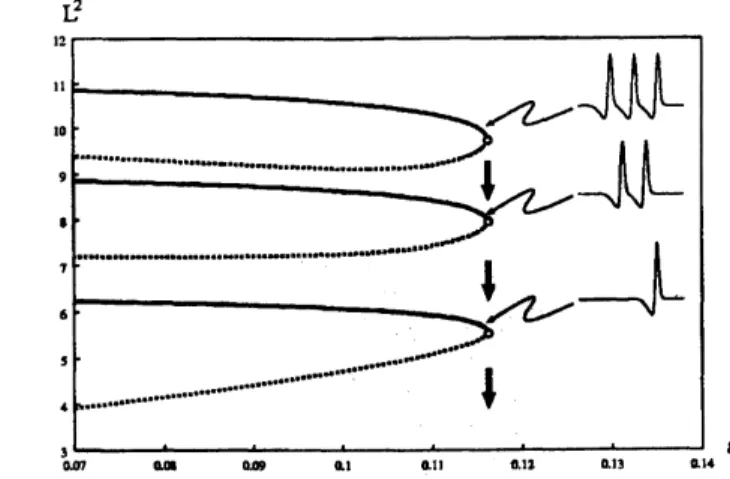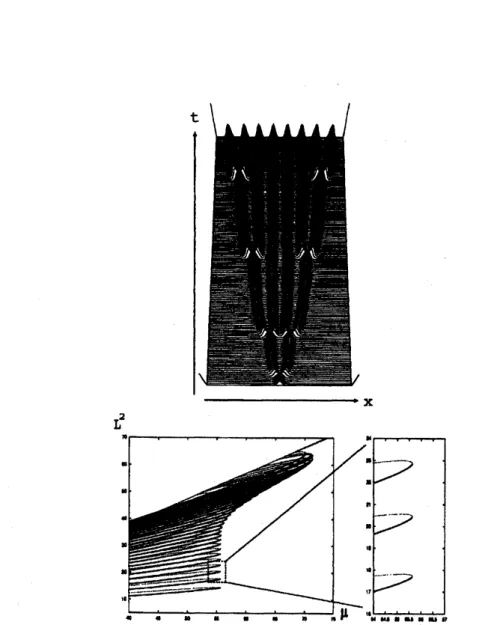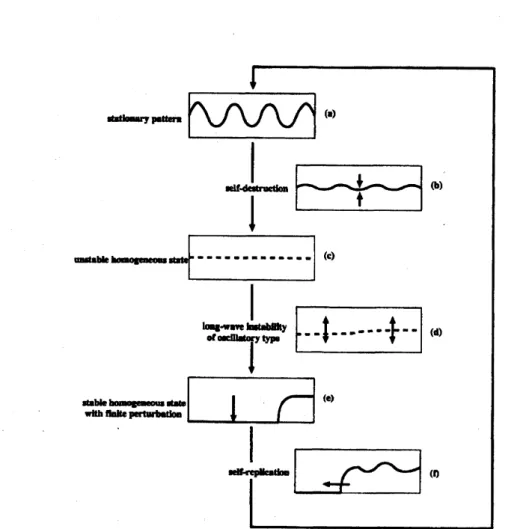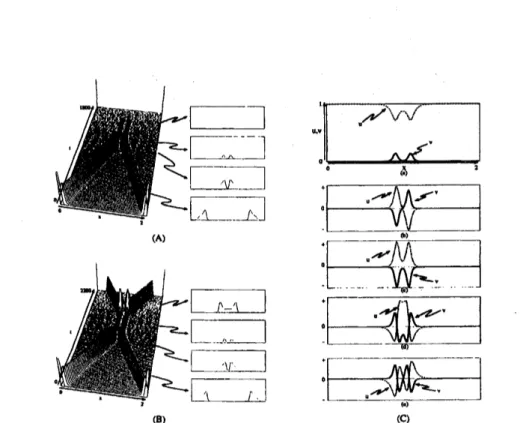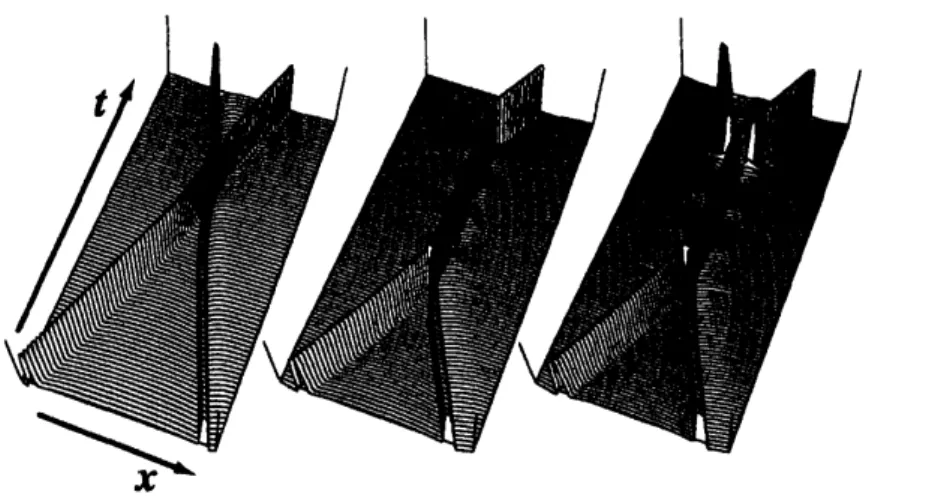Strong
Interactions
among
Particlelike
Solutions
in
Dissipative
Systems
Research Institute
for
Electronic
Science
Hokkaido University
Yasumasa
Nishiura
Abstract
Three typical transient dynamics in dissipative systems are dis
cussed, namelyself-replication, self-destruction, and scatteringamong
spatially localized patterns. The difficulty lies in the fact that
pat-terns are deformed alot and the associatedorbits behave globally in the phase space. Aconventional treatment in general does not work and needs anew viewpoint to describe them. Our strategy is not to
$\mathrm{t}\mathrm{r}\mathrm{a}\mathrm{c}\mathrm{e}$the orbital behavior iteself, but to search aglobal structure of
networkofbifurcatingsolutionswhichdrives such transient dynamics.
Ahierarchy structureofsaddle-node bifurcationpointsplays acrucial
role for self-replication and self-destruction processes, and unstable patterns called scattors forscattering process. The aimofthis note is to clarify what are the issues and convey the basic ideas to overcome
them.
1Introduction
Scattering ofparticle-like patterns in dissipative systems isstudied, especially
we focus ontheissue how theinput-0utputrelation is controlled at ahead-0n
collisionwhere traveling pulses
or
spots interact strongly. Itremainsan
openproblem due to the large deformation ofpatterns at acolliding point. We
found that special type ofunstable steady
or
time-periodic solutions calledscattors and their stable and unstable manifolds direct the traffic flow of
orbits. Such scattors
are
in general highly unstableeven
in 1Dcase
whichcauses
avarietyofinput-0utput relationsthroughthescatteringprocess. We数理解析研究所講究録 1330 巻 2003 年 88-100
illustrate the ubiquity of scattors by using the complex Ginzburg-Landau
equation, the Gray-Scott model and athree-component reaction diffusion
model arising in gas-discharge phenomena.
We focus on the dynamic patterns of spatially localized patterns such
as
pulses and spots in dissipative systems, especially
we are
interested in thefollowing transient type of dynamics
”Self-replication, Self-destruction, and Scattering”.
The
reason
is thatcomplicateddynamicsas
in Figs 1and 2couldbeobtainedby combination of those dynamics. Fordefiniteness, weemploy thefollowing
Gray-Scott model (see for instance, [2], [15]), although the strategy below
seems to work also for other model systems. Here we only describe the
outline of the results, the readers
are
encouraged to consult the referencesuch
as
[10], [11], [12], [13], and [14]. See also the related reference [7], [8],[9].
$\{$
$\frac{\partial u}{\partial \mathrm{t}}=D_{\mathrm{u}}\Delta u-uv^{2}+F(1-u)$
$\frac{\partial v}{\partial t}=$ $D_{v}\Delta v+uv^{2}-(F+k)v$,
(1)
The simulations depicted in Figs 1and 2show
some
aspectsofthe dynamicsbuilt in this system. The issues
are
1. Self-replication and self-destruction and their relevance to understand
complex spati0-temporal dynamics.
2. Scattering phenomena through collisions among particlelike patterns.
In Fig. 1ordered states
are
observed locally in space and time, howeverthose
are
transient patterns and the orbits itinerate several different statesthrough splitting and destruction. Scattering phenomenalike Fig.7 and Fig.8
showpeculiar type of solutions called scattors to which the orbits comeclose
near transitionpointsof input-0utput relations. However from mathematical
point of view there
are
acouple of difficulties to overcome, namely$\bullet$ The patterns
are
deformed to alarge extent.$\bullet$ The orbits itinerate globally in the phase space.
$\bullet$ It is not aproiori clear how to reduce the dynamics into finite
dimen-sional space.
Figure 1: $2\mathrm{D}$ SaptiO-temporal chaos for the Gray-Scott model.
Figure 2: Spatio temporal self-similar pattern for the Gray-Scott model.
Self-replication and annhilation
are
combined together to create aSierpinskigasket-like patterns. This
was
first found by Hayase and Ohta [6] for thereaction-diffusion system of Bonhoeffer-van der Pol type.
It
seems
an appropriate computational approach is indispensable to findmechanisms which drive those dynamics, and then set up aframework for
rigorous analysis. Conventional techniques such as bifurcation analysis,
sin-gular perturbation, and
some
asymptotic methods areuseful to someextent,however those are not sufficient to clarify the most essential aspect. It turns
out that aset of bifurcating branches form anetwork in an organized way
and it becomes ahidden mechanism driving the orbits in various ways. This
note is based
on
the joint works with D.Ueyama, K.-I.Ueda, S.-I.Ei andT.Teramoto.
2Weak and
strong
interactions
among
par-ticlelike
patterns
Atypical example of strong interaction isthe annihilation oftraveling pulses
of the FitzHugh-Nagumo equations at head-0n collision, which still remains
open problem in rigorous
sense.
Self-replication and self-destructionas
inFig.l belong to another category of strong interaction, namely the pattern
splits or destructs by iteself. The following two complimentary approaches
may work well
\bullet Pulse interaction approach with instabilities.
\bullet To find ageometric characterization for the set of global
sx
lution branches which drives such dynamics.
Theformerone is aperturbativemethod and
was
initiatedby physists,how-ever rigorous analysis is rather recent (see. for instance, [3], [4], [5] ). The
latter one developped by [10], [11], [14]
owes
very much to the recentdevel-opment of fast computer and path-trackingsoftware like AUTO([I]).
3Self-replication
and
self-destruction
Unlike soliton pulses the localized pulses in dissipative systems
can
dupli-cate and annihilate spontaneously. One may think that the dynamics of
self-replication has nothing to do with the destruction process, however it
turnsout that they have basicalythe
same
structure ffombifurcationalviewpoint, namely they share the
common
structure called “hierarchy structureof saddle-node points”. See
more
precisely [14]. Herewe
briefly describe thedestruction process ofmultiple-pulseswith oscillatory tailsforthe
FitzHugh-Nagumo (FHN) equations. It is known that FHN has astable
multiple-travelingpulse in someparameter region ifithas an oscillatorytail, however
such amultiple-pulse destruct by itself when the threshold parameter $a$ is
increasedlikeFig.3. Theinteresting thingis that it doesnot collapseat once,
but destruct successively. In other words, the top
one
first dies out, then ittravels for awhile like atw0-pulse, but again the first hump disappear and
it eventually collapses after traveling as asingle pulse for certain time. The
associated bifurcation diagram is depicted
as
in Fig.4 in which ahierarchystructure of saddle-node points is clearly visible and self-destruction process
isobservedslightlyoff thelocationof it. It should be remarked thatdynamics
ofself-destruction is observed in aregion where there
are no
branchescorre-sponding to traveling pulses, nevertheless it is clear that the above hierarchy
structure drives such adynamics behind the
scenes.
Also such astructuretells you about the onset of such adestruction, i.e., location of saddle-node
point.
Figure 3: Self-destruction oftriple-pulse with oscillatory tail.
Self-replication is an inverse process of the above destruction dynamics,
namely the unstablemanifold ofsay, one-hump pattern is connected to
tw0-hump pattern, i.e., the increasing direction. Here
we
only show aglobalbifurcation diagram for the
Gierer-Meinhardt
model arising in the morphogenesis
as
in Fig.5. It is clearlyseen
that hierarchy structure of saddle-nodepoints drives self-replication dynamics
as
in the above evolution numericsof Fig.5 where pulses repel each other and its number increases not like
$arrow 2arrow 4arrow 8$ proportional to $2^{n}$, but $1arrow 2arrow 4arrow 6$
.
This is because only pulseslocated at the edge
are
able to split. Wecan
prove the edge splittingphe-nomena
rigorouslyby using pulse-interaction method [4]. The principal part$\mathrm{L}^{2}$
$\mathrm{a}$
Figure4: Globalbifurcation diagram for multiple-pulseswithoscillatorytails.
The abscissa is the threshold parameter $a$ and the ordinate shows
anorm
ofthe pulses. The locationof each saddle-node point coincide almost perfectly
and self-destruction
occurs
when $a$ exceeds this critical point.of the resulting equations read
$\dot{h}_{1}$
$=-M_{0}(e^{-\alpha h\mathrm{a}}-2e^{-\alpha h_{1}})$
$.\dot{h}_{j}$ $=-M_{0}(e^{-\alpha h_{j-1}}-2e^{-\alpha h_{\mathrm{j}}}+e^{-\alpha h_{j+1}})$ $h_{N}$ $=-M_{0}(e^{-\alpha h_{N-1}}-2e^{-\alpha h_{N}})$
(2)
$\dot{r}_{0}$ $=M_{1}r_{0}^{2}-\epsilon M_{2}-M_{3}e^{-\alpha h_{1}}$
$\dot{r}_{N}\dot{r}_{j}$ $=M_{1}r_{N}-\epsilon M_{2}-M_{3}e^{-\alpha h_{N}}=M_{1}r_{\dot{\S}}^{2}-\epsilon M_{2}-M_{3}(e^{-\alpha h_{\mathrm{j}+1}}+e^{-\alpha h_{\mathrm{j}}})$
where $r_{j}$ denotes the depth of dimple of each pulse, $h_{j}$ the distance between
pulses, $\epsilon$ signed distance from the saddle-node point and all the coefficients
$M_{j}$
are
positive. Note that the equations for $h_{j}$ decouple the equations for$r_{j}$, therefore it
can
be analysed independently. In fact $h_{j}$ basically increasesmonotonically due to the repulsion, onthe otherhand, whether aconcerning
pulse splits or not is determined by whether $r_{j}$ starts to increase rapidly
or
remains finite. In view of the right-hand side of $r_{j}$, the intercept of theparabola is crucial for this. It turms out that the pulse with the largest
$h_{j}$ primarily starts to split, and such pulses should be located at edge, i.e.,
edge-splitting ([4]), which is consistent with Fig.5.
Figure5: Self-replicationprocessfor theGierer-Meinhardtmodel. Theupper
one
shows the evolution in 1Dcase.
The lowerone
is the associated globalbifurcationdiagramforthe set of$\mathrm{N}$-humpstanding pulses
on
afinite interval.The bifurcation parameter $\mu$ is the decay-rate for the inhibitor.
4
SpatiO-temporal
chaos with
replication
and
destruction
It may be achallenge to construct aexotic transient dynamics, say
spati0-temporal chaos by piecing replication and destruction together. One of the
difficulties is how to tune parameters not to fall in aattractor but to keep
each characteristic dynamics. Recall that the destruction process of
muti-pulses in Fig.3 ends up with the stable rest state and nothing happens after
that. We need to somehow destabilize the final state and activate it to
re-enter into anontrivialstate. This is arealglobal problemandcomputational
approach is indispensabletoclarify the situation. Oneofthegoodcandidates
for mechanisms creating such adynamics is generalized heteroclinic cycle in
infinite dimensional space (see Fig.6). See [11] for details.
5Scattering
among particlelike patterns
So far
we
consider the destabilizations of localized patterns by themselves,i.e., without interaction with other patterns. The other important class of
strong interactions is scattering among moving localized objects. Avariety
of different types of input-0utput relations are reported in experiments and
numerics (see the reference in [12], [13]). Genericaly in dissipative systems
not only the velocity and the profile ofthe traveling objects but also
input-output relationdepends on the parameters. The detailed process connecting
input tooutput duringthe collisionis quitehardtodescribeevennumerically,
therefore it is necessary to introduce
anew
viewpoint. Whatwe
presenthere is the special type of unstable patterns called scattors which control
the flows
near
the transition points. Originally thiswas
strongly motivatedby the numerics on the head-0n collision of 1D pulses for the Gray-Scott
model when the parameters
are
chosen to be close to the transition pointfrom annihilation to repulsion. The stable manifold of the scattor is loosely
speaking
an
infinite-dimensional version ofseparatrix in ODE, however it ismuch
more
subtle and difficult to find it even by numerics. Herewe
onlypresent just
one
example of such ascattor arsing in the Gray-Scott model.For
more
details and applications to other model systems,we
refer to [12]and [13].
From repulsion to annihilation
First $F$ is fixed to be 0.0198 and study asymmetric coUision. When $k$ is
increased and exceeds $k_{c}\approx 0.0497859$, the input-0utput relation changes
from annihilation (A) to repulsion (B)
as
in Fig.7. The input-0utput relationdepends
on
the initial condition, therefore in order to make the transitionFigure 6: Heteroclinic cycle
on
the infinite line passing through aunstablehomogeneous state $P,$ $(1,0)$, and aspatially periodic pattern for the
Gray-Scott model. The homegeneous state $P$ is unstable for large wave-length
region originated from Hopf instability. Strictly speaking, such acycle does
not exist on afiniteinterval, since $(1, 0)$ is stableinthePDE sense. However,
after replacing $(1, 0)$ by $(1, 0)$ with trigger (the resulting cycle is called
a
generalizexlheterocliniccycle),wecanobserve
an
aftereffect of thegeneralizedcycle numerically. Here, $(1, 0)$ with trigger
means
that there issome
portionof the interval where $(u, v)$ is notequal to $(1, 0)$ and from which areplication
wave
can
start propagating.$\mathrm{u}^{\wedge}j^{\bigwedge_{\mathrm{i}}}$ ’ ’
$0l-\mathrm{F}_{-\mathrm{T}}^{\mathrm{r}\prime^{\prime\approx}}.\ovalbox{\tt\small REJECT}_{-}^{1}.$
’
(B) (C)
Figure 7: Symmetric collisions for $F=0.0198$
.
(A) Annihilationoccurs
at$(k, F)=(0.0497859, 0.0198)$
.
(B) As $k$ is slightly increased to 0.0497860,transition from annihilation to repulsion
occurs.
Note that just before theoccurrence of annihilation or creation of counter-propagating pulses, both
orbits in (A) and (B) stay very close to the separator depicted in (C)(a).
Only$v$-componentis shownin (A) and (B). (C)(a)Theprofileof theunstable
steady state of $\mathrm{c}\mathrm{o}\dim 3$ (scattor). Three unstable eigenfunctions $\phi_{1},$$\phi_{2},$$\phi_{3}$
are
depictedas
$(\mathrm{b})-(\mathrm{d})$, and (e) corresponds to the Goldstone mode. Theassociated eigenvalues
are
$\lambda_{1}=0.06389>\lambda_{2}=0.06378>\lambda_{3}=0.00233$.
Thefirst two eigenvalues
are
muchlargerthan the first one. Thesolid (gray)line indicates $v(u)$-component.
Figure 8: Three different type of input-0utput relations for the
three-component model. Repulsion (left):Tw(\succ into-two case. Number of emitting
pulses
are
preserved. Fusion(middle): Two intoone
case.
After merging, thefused pattern oscillates for awhile, then emits one traveling pulse. Oscilla
tory repulsion (right): TwO-int0-two case. Two traveling pulses fused into
one
localized wave, then oscillates for certain time, and finnaly splits intotwo counter propagating pulses. See [13] for details.
point $k_{c}$ to bewell-defined,
we
have to specify the class of initial conditions.Theoretically
we
employ asymmetric pair of true traveling pulsesas an
initial condition, which starts initially at $x=\pm\infty$ and collides at the origin.
Practically such
an
initial data and the resulting $k_{c}$are
well approximatedby takingawell-settled symmetric pair ofpulses. Aremarkable thing is that
there appearsaquasi-steadystate oftwin-horn shape rightaftercollisionand
the orbit approaches it, stays there for certaintime, then annihilate
or
emittwo pulses. In fact thereexists areal steady stateof twin-horn shape, which
is numerically confirmed by the Newton method as in Fig.7. This is what
we call ascattorfor the Gray-Scott model. Alinearized eigenvalue problem;
$L\phi=\lambda\phi$ where $L$ is the linearized operator of the right-hand side of the
system (1) around the twin-horn steady state has three unstable eigenvalues
$\lambda_{1}=0.06389>\lambda_{2}=0.06378>\lambda_{3}=0.00233$ besides the
zero
eigenvalueA4
coming from thetranslation invariance (see Fig.7(C)). Note that the firsttwo eigenvalues
are
much larger than the third one, hence the dynamics isbasicaly controlled by$\lambda_{1}$ and $\lambda_{2}$
.
The associated eigenfunctionsare
denotedby $\phi_{:}(i=1, \cdots, 4)$
.
The twin-horn scattor plays arole as atraffic controllerat collision. Infact,forsymmetrichead-0ncollision,the second eigenfunction
plays
an
important role to determine the fate of the orbit, namely, addingits small constant-multiple perturbation to the twin-horn pattern, then the
resulting behavior is either annihilation or emissionof two pulses depending
onits signofconstant. Inother words theoutput
can
beclassified by lookingat the response ofthe separator alongthe unstable manifold. In this section
weproposedanewviewpointfrom scattors. Scattors may be unstablesteady
states or time-periodic solutions and their codimensions (i.e., the number
of unstable eigenvalues) is in general high and the origin of adiversity of
input-0utput relations
can
be reducedto the localdynamics around scattors.We illustrated this viewpoint by using the Gray-Scott model. The orbit
typically approachesascattorrightaftercollisionandissorted outgenerically
along one of the unstable directions ofit. The output
can
be predictable byusing the information on the solution profile right after collision, scattorss
and their unstable eigenforms. Scattorss in dissipative systems
seems
to beubiquitous and useful to understand the scattering process, in fact
even
inhigher dimensional space such separators
are
recently found numerically forvarious modelsincluding the 3-component system presentedin Fig.8. See[13]
for details and forthcoming articles..
References
[1] E.J.Doedel, A.R.Champneys, T.F.Fairgrieve, Y.A.Kuznetsov,
B.Sandstede and X.Wang,AUTO97..Continuation and
bifurca-tion
software
for
ordinarydifferential
equations (with HomCont),$\mathrm{f}\mathrm{t}\mathrm{p}://\mathrm{f}\mathrm{t}\mathrm{p}.\mathrm{c}\mathrm{s}$.concordia.$\mathrm{c}\mathrm{a}/\mathrm{p}\mathrm{u}\mathrm{b}/\mathrm{d}\mathrm{o}\mathrm{e}\mathrm{d}\mathrm{e}\mathrm{l}/\mathrm{a}\mathrm{u}\mathrm{t}\mathrm{o}$,(1997).
[2] P.Gray and S.K.Scott,Autocatalytic reactions in the isothemlal,
contin-uous stirred tank reactor: oscillations and instabilities in the system $A$
$+\mathit{2}Barrow \mathit{3}B,$ B $arrow C$,Chem. Eng. Sci. Vo1.39(1984) 1087-1097.
[3] Shin-IchiroEi, Masayasu Mimuraand MasaharuNagayama, Pulse-pulse
interactionin
reaction-diffusion
systems, Physica D, $165(2002)176- 198$.
[4] Shin-Ichiro Ei, Yasumasa Nishiura and Kei-ichi Ueda, $2^{n}$-splitting
or
Edge-splitting -A Manner
of
splitting in dissipative systems, JapanJ.Ind.Appl.Math. 18(2) (2001)181-205.
[5] Shin-Ichiro Ei, Yasumasa Nishiura and Kei-ichi Ueda, Splitting
of
trav-eling
waves
in reactiondiffusion
systems with monO-stable excitability,preprint.
[6] Y.HayaseandT.Ohta, Sierpinski Gasketin a
Reaction-Diffusion
system,PRL 81(8)(1998) 1726.
[7] W.N.Reynolds, S.Ponce-Dawson, and J.E.Pearson Self-replicating spots in
reaction-diffusion
systems, Phy.Rev.E 56,185-198
(1997).[8] A.Doelman, W.Eckhaus, and T.Kaper Slowly-modulated twO-pulse
s0-lutions in the Gray-Scott model II..geometric theory,
bifurcations
andsplitting dynamics SIAM J.Appl.Math. 61, 2036-2062 (2001).
[9] C.Muratov and V.Osipov $\pi aveling$ Spike AutO-Solitons in the
Gray-Scott Model Physica D $155,112- 131$ (2001).
[10] Yasumasa Nishiura and Daishin Ueyama, A
skeleton stretcture
of
self-replicating dynamics, Physica D, $130(1999)73- 104$
.
[11] Yasumasa Nishiura and Daishin Ueyama, Spati0-tempomlchaos
for
theGray-Scott model, Physica D $150(2001)137- 162$
.
[12] YasumasaNishiura, TakashiTeramotoand Kei-ichi Ueda Scattering and
separators in dissipative systerres, to appear in PRE.
[13] YasumasaNishiura, Takashi Teramoto and Kei-ichi Ueda Dynamic
tran-sitions through scattors in dissipative systems, to appear in Chaos.
[14] Yasumasa Nishiura, Far-from-equilibrium Dynamics, AMS, (2002).
[15] J.E.Pearson., Complex patterns in a simple system, Science
$\mathrm{V}\mathrm{o}\mathrm{l}.216(1993),189- 192$
